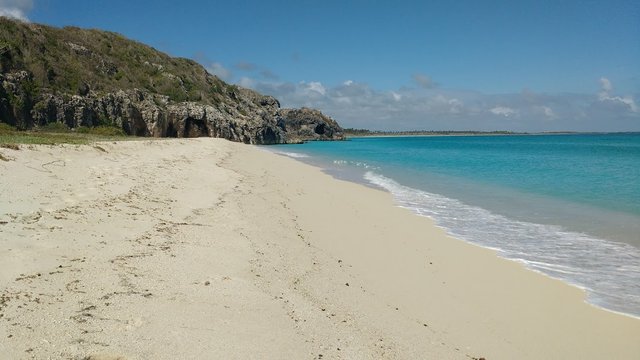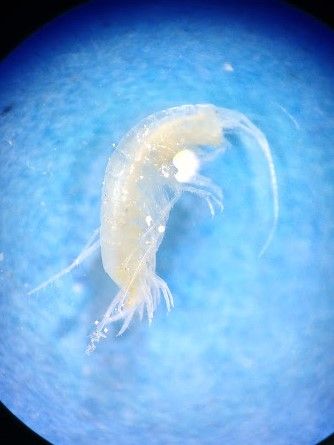Anchialine pools: a window to a hidden world
The term anchihaline was defined initially by Holthuis (1973) and derives from the Greek "anqui = close", "halos = sea", referring to the proximity of these environments to the sea. These pools (also known as cenotes, blue holes or subterranean estuaries) are found in caves and have underground connections that connect with the sea, and there is a "struggle" between the continental freshwater that goes towards the sea and the water marine that ascends through those same galleries, driven by the action of the tides.
 Figure 1: Mallorquines beach, 30 meters away from the anchialine pool in the Morrocoy National Park, Falcón state (Author photo).
Figure 1: Mallorquines beach, 30 meters away from the anchialine pool in the Morrocoy National Park, Falcón state (Author photo).
Characteristics of anchialine pools
These environments resemble the ocean depths due to the absence of light, the stability of environmental conditions and isolation and they are considered unique habitats in which relict organisms or "living fossils" of different groups have been maintained, with a common origin that in some cases goes back to 250 Ma (Holsinger, 1991).
The trofic chains of the anchialine ecosystems are generally simple, they are characterized to have few trophic levels. The diets of underground organisms are commonly polyphagous, as the main adaptive response of organisms in the face of food shortages. This has been observed in the feeding mode of fish and several crustaceans such as Remipedia (see video 1).
In addition to metabolic adaptations to scarce food sources, the anquialine fauna also presents adaptations in response to the physical conditions of the environment. The permanent darkness has generated the loss of pigmentation, ocular regression (absence of eyes) and a high sensory capacity that is manifested in the hypertrophy of the sensory organs.

Figure 2: Fish with morphological characters adapted to the subterranean environment (Camacho, 1992).
Anchialine environments in the world
The distribution of these ecosystems in the world is totally discontinuous, and they have been reported mainly in the Caribbean islands and the Indian Ocean, with few exceptions along the continental margins, such as in the Yucatán Peninsula (México), Pilbara (Australia) and the Falcón state (Venezuela).
In Venezuela these environments have been reported only by Jean Stock (1986) who mentioned the finding of an anchialine cave in the Mallorquines coastal karst during an exploration carried out in 1982. Since then these caves have remained ignored by researchers until the 2015, when it was initially proposed as my thesis project to study the fauna of this particular ecosystem. However, the location of these environments was very difficult because who reported this environment for the first time did not know the region, and the reference data they provided was not correct. Even so, after two trips to the Mallorquines karst it was possible to find the place and proceed to carry out part of the studies proposed.
Figure 3: Navigation in the coastal karst of Mallorquines in search of anchihaline environments (Working group photo).
This anchialine cave is located an hour away from the Chichiriviche harbour, and the entrance to this cave is located a few meters above sea level, reaching the water table after a fairly steep slope, so the access is usually quite difficult (Figure 4).
Figure 4: Entrance to the anchihaline pool in the coastal karst of Mallorquines, Falcón state (Working group photo).
In this cave the darkness is total and the water fills several wells of considerable depth (8 to 12 m) between large karst stones (Figure 5). The water is crystalline and the trophic resources seem to be quite scarce, since no plant material and very few amounts of guano were observed.
Figure 5: Anchialine pool where you can see the underground channels that communicate with the sea water (Working group photo).
Biological diversity in anchialine pools
Groundwater frequently hosts fish, amphibians, echinoderms, annelids, gastropods and certain insects. However, crustaceans are the main representatives of this ecosystems and their richness can be greater or at least comparable to that observed in continental epigeous waters.
During the samplings made in these caves it was possible to capture crustaceans of different orders that are still in process of identification and observe some fish (their capture was not possible). It is important to note that the crustaceans collected as the observed fish did not posses pigmentation or eyes as an adaptation to life in these environments.
Figure 6: During samplings performed in anquihaline cave (Working group photo).
Figure 7: Exploring anquihaline cave by boat (Working group photo).

What is known so far, anchialine environments of the Mallorquines coastal karst are not disturbed due to the isolation and difficult access of these aquatic caves. However, these environments should be considered at risk due to the growing tourism development in this region. Finally, the close relationship between the balance in these caves and what happens outside makes it urgent to consider a special protection for these fragile ecosystems scarcely documented, where the vast majority of species are endemic.
References
Bishop, R., Humphreys, W., Cukrov, N., Žic, V., Boxshall, G., Cukrov, M., & Sket, B. 2015. ‘Anchialine’redefined as a subterranean estuary in a crevicular or cavernous geological setting. Journal of crustacean biology, 35(4), 511-514.
Holsinger JR. 1991. What can vicariance biogeographic models tell us about the distributional history of subterranean amphipods?. Hydrobiologia; 223: 43-5.
Holthuis L. 1973. Caridean shrimps found in land-locked saltwater pools at four Indo-West Pacific localities. Zool. Verhand., 128: 1-48.
Koenemann, S., Bloechl, A., Martínez, A., Iliffe, T. M., Hoenemann, M., & Oromí, P. 2009. A new, disjunct species of Speleonectes (Remipedia, Crustacea) from the Canary Islands. Marine Biodiversity, 39(3), 215-225.